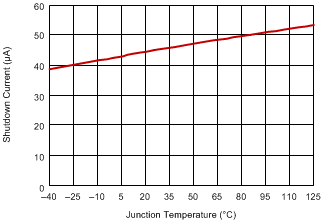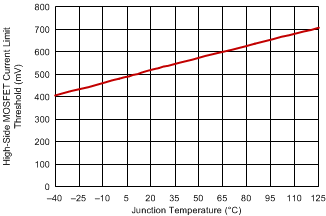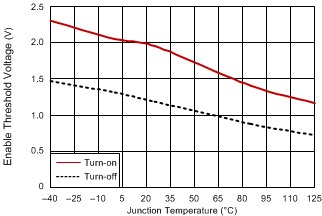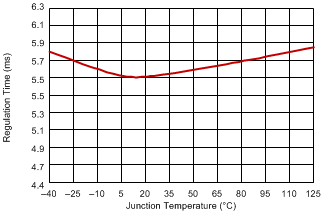SLUS719H MARCH 2007 – May 2019 TPS40192 , TPS40193
PRODUCTION DATA.
- 1 Features
- 2 Applications
- 3 Description
- 4 Revision History
- 5 Pin Configuration and Functions
- 6 Specifications
- 7 Detailed Description
-
8 Application and Implementation
- 8.1 Application Information
- 8.2
Typical Application
- 8.2.1 Design Requirements
- 8.2.2
Detailed Design Procedure
- 8.2.2.1 Selecting the Switching Frequency
- 8.2.2.2 Inductor Selection
- 8.2.2.3 Output Capacitor Selection (C8)
- 8.2.2.4 Peak Current Rating of the Inductor
- 8.2.2.5 Input Capacitor Selection (C7)
- 8.2.2.6 MOSFET Switch Selection (Q1, Q2)
- 8.2.2.7 Boot Strap Capacitor
- 8.2.2.8 Input Bypass Capacitor (C6)
- 8.2.2.9 BP5 Bypass Capacitor (C5)
- 8.2.2.10 Input Voltage Filter Resistor (R11)
- 8.2.2.11 Short Circuit Protection (R9)
- 8.2.2.12 Feedback Compensation (Modeling the Power Stage)
- 8.2.2.13 Feedback Divider (R7, R8)
- 8.2.2.14 Error Amplifier Compensation (R6, R10, C1, C2, C3)
- 8.2.3 Application Curves
- 9 Power Supply Recommendations
- 10Layout
- 11Device and Documentation Support
- 12Mechanical, Packaging, and Orderable Information
Package Options
Mechanical Data (Package|Pins)
- DRC|10
Thermal pad, mechanical data (Package|Pins)
- DRC|10
Orderable Information
6.7 Typical Characteristics
 Figure 1. Relative Reference Feedback Voltage vs Junction Temperature
Figure 1. Relative Reference Feedback Voltage vs Junction Temperature 
| VENABLE < 0.6 V |
 Figure 5. Soft-start Time vs Junction Temperature
Figure 5. Soft-start Time vs Junction Temperature  Figure 7. High-Side MOSFET Current Limit Threshold vs Junction Temperature
Figure 7. High-Side MOSFET Current Limit Threshold vs Junction Temperature  Figure 9. Power-Good Threshold voltage vs Junction Temperature
Figure 9. Power-Good Threshold voltage vs Junction Temperature  Figure 11. Relative Overcurrent Trip Point vs Freewheel Time
Figure 11. Relative Overcurrent Trip Point vs Freewheel Time  Figure 2. Relative Oscillator Frequency Change vs Junction Temperature
Figure 2. Relative Oscillator Frequency Change vs Junction Temperature  Figure 4. Enable Threshold Voltage vs Junction Temperature
Figure 4. Enable Threshold Voltage vs Junction Temperature  Figure 6. Low-Side MOSFET Current Limit Threshold vs Junction Temperature
Figure 6. Low-Side MOSFET Current Limit Threshold vs Junction Temperature  Figure 8. Total Time to Regulation vs Junction Temperature
Figure 8. Total Time to Regulation vs Junction Temperature  Figure 10. Shutdown Current vs Input Voltage
Figure 10. Shutdown Current vs Input Voltage